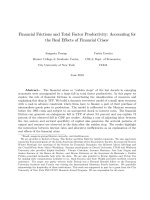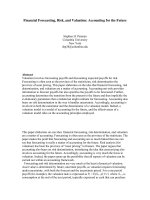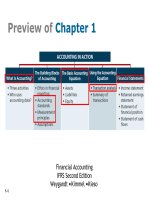Financial accounting chapter 08 accounting for receivables
Bạn đang xem bản rút gọn của tài liệu. Xem và tải ngay bản đầy đủ của tài liệu tại đây (778.13 KB, 55 trang )
8-1
Preview of Chapter 8
8-2
Amounts due from individuals and other companies that are
expected to be collected in cash.
Amounts owed by
customers that
result from the sale
of goods and
services.
Accounts
Accounts
Receivable
Receivable
Accounts
Accounts
Receivable
Receivable
LO 1 Identify the different types of receivables.
Written promise (as
evidenced by a
formal instrument)
for amounts to be
received.
“Nontrade” (interest,
loans to officers,
advances to
employees, and
income taxes
refundable).
Notes
Notes
Receivable
Receivable
Notes
Notes
Receivable
Receivable
Other
Other
Receivables
Receivables
Other
Other
Receivables
Receivables
Types of Receivables
8-3
Amounts due from individuals and other companies that are
expected to be collected in cash.
LO 1 Identify the different types of receivables.
Illustration 8-1
Types of Receivables
8-4
Three accounting issues:
1. Recognizing accounts receivable.
2. Valuing accounts receivable.
3. Disposing of accounts receivable.
LO 2 Explain how companies recognize accounts receivable.
Service organization - records a receivable when it
provides service on account.
Merchandiser - records accounts receivable at the point
of sale of merchandise on account.
Recognizing Accounts Receivable
Accounts Receivable
8-5
Illustration: Assume that Hennes & Mauritz (SWE) on July 1,
2014, sells merchandise on account to Polo Company for $1,000
terms 2/10, n/30. Prepare the journal entry to record this
transaction on the books of Hennes & Mauritz.
Accounts receivable 1,000Jul. 1
Sales revenue
1,000
Accounts Receivable
LO 2 Explain how companies recognize accounts receivable.
8-6
Illustration: On July 5, Polo returns merchandise worth $100 to
Hennes & Mauritz (SWE).
Sales returns and allowances 100Jul. 5
Accounts receivable
100
On July 11, Hennes & Mauritz receives payment from Polo
Company for the balance due.
Cash 882Jul. 11
Sales discounts ($900 x .02) 18
Accounts receivable
900
Accounts Receivable
LO 2 Explain how companies recognize accounts receivable.
8-7
Interest receivable
4.50
Illustration: Some retailers issue their own credit cards. Assume
that you use your JCPenney (USA) credit card to purchase
clothing with a sales price of $300.
Accounts receivable 300
Sales revenue
300
Assuming that you owe $300 at the end of the month, and
JCPenney charges 1.5% per month on the balance due
Accounts receivable 4.50
Accounts Receivable
LO 2 Explain how companies recognize accounts receivable.
8-8
Valuing Accounts Receivable
Current asset.
Valuation (net realizable value).
Uncollectible Accounts Receivable
Sales on account raise the possibility of accounts not
being collected.
Seller records losses that result from extending credit
as Bad Debt Expense.
LO 3 Distinguish between the methods and bases
companies use to value accounts receivable.
Accounts Receivable
8-9
Allowance Method
Allowance Method
Losses are estimated:
Better matching.
Receivable stated at cash
realizable value.
Required by IFRS.
Methods of Accounting for Uncollectible Accounts
Direct Write-Off
Direct Write-Off
Theoretically undesirable:
No matching.
Receivable not stated at
cash realizable value.
Not acceptable for financial
reporting.
Accounts Receivable
LO 3 Distinguish between the methods and bases
companies use to value accounts receivable.
8-10
How are these accounts presented on the Statement of
Financial Position?
Accounts Receivable
Allowance for
Doubtful Accounts
Beg. 500 25 Beg.
End. 500 25 End.
Accounts Receivable
8-11
Accounts Receivable
8-12
Allowance for
Doubtful Accounts
Beg. 500 25 Beg.
End. 500 25 End.
Accounts Receivable
Journal entry for credit sale of $100?
Accounts receivable 100
Sales 100
Accounts Receivable
8-13
Allowance for
Doubtful Accounts
Beg. 500 25 Beg.
End. 600 25 End.
Accounts Receivable
Journal entry for credit sale of $100?
Accounts receivable 100
Sales 100
Sale 100
Accounts Receivable
8-14
Allowance for
Doubtful Accounts
Beg. 500 25 Beg.
End. 600 25 End.
Sale 100
Accounts Receivable
Collected $333 on account?
Cash 333
Accounts receivable 333
Accounts Receivable
8-15
Allowance for
Doubtful Accounts
Beg. 500 25 Beg.
End. 267 25 End.
Sale 100
Accounts Receivable
Collected $333 on account?
Cash 333
Accounts receivable 333
333 Coll.
Accounts Receivable
8-16
Allowance for
Doubtful Accounts
Beg. 500 25 Beg.
End. 267 25 End.
Sale 100 333 Coll.
Accounts Receivable
Adjustment of $15 for estimated bad debts?
Bad debt expense 15
Allowance for Doubtful Accounts 15
Accounts Receivable
8-17
Allowance for
Doubtful Accounts
Beg. 500 25 Beg.
End. 267 40 End.
Sale 100 333 Coll.
Accounts Receivable
Adjustment of $15 for estimated bad debts?
Bad debt expense 15
Allowance for Doubtful Accounts 15
15 Est.
Accounts Receivable
8-18
Allowance for
Doubtful Accounts
Beg. 500 25 Beg.
End. 267 40 End.
Sale 100 333 Coll.
15 Est.
Accounts Receivable
Write-off of uncollectible accounts for $10?
Allowance for Doubtful accounts 10
Accounts receivable 10
Accounts Receivable
8-19
Allowance for
Doubtful Accounts
Beg. 500 25 Beg.
End. 257 30 End.
Sale 100 333 Coll.
15 Est.
Accounts Receivable
Write-off of uncollectible accounts for $10?
Allowance for Doubtful accounts 10
Accounts receivable 10
W/O 10 10 W/O
Accounts Receivable
8-20
Accounts Receivable
8-21
Illustration: Assume that Warden Co. writes off M. E. Doran’s
HK$1,600 balance as uncollectible on December 12.
Warden’s entry is:
Bad debts expense 1,600
Accounts receivable
1,600
Direct Write-off Method for Uncollectible Accounts
Accounts Receivable
Theoretically undesirable:
No matching.
Receivable not stated at cash realizable value.
Not acceptable for financial reporting.
LO 3
8-22
Allowance Method for Uncollectible Accounts
1. Companies estimate uncollectible accounts
receivable.
2. Debit Bad Debt Expense and credit Allowance for
Doubtful Accounts (a contra-asset account).
3. Companies debit Allowance for Doubtful Accounts
and credit Accounts Receivable at the time the
specific account is written off as uncollectible.
Accounts Receivable
LO 3 Distinguish between the methods and bases
companies use to value accounts receivable.
8-23
Illustration: Hampson Furniture has credit sales of
€1,200,000 in 2014, of which €200,000 remains uncollected at
December 31. The credit manager estimates that €12,000 of
these sales will prove uncollectible.
Bad debt expense 12,000Dec. 31
Allowance for doubtful accounts
12,000
Accounts Receivable
LO 3 Distinguish between the methods and bases
companies use to value accounts receivable.
8-24
Illustration 8-3
Presentation of allowance
for doubtful accounts
Accounts Receivable
LO 3 Distinguish between the methods and bases
companies use to value accounts receivable.
8-25
Illustration: The financial vice-president of Hampson Furniture
authorizes a write-off of the €500 balance owed by R. A. Ware on
March 1, 2015. The entry to record the write-off is:
Allowance for doubtful accounts 500Mar. 1
Accounts receivable
500
Illustration 8-4
Accounts Receivable
LO 3 Distinguish between the methods and bases
companies use to value accounts receivable.
Recording Write-Off of an Uncollectible Account









